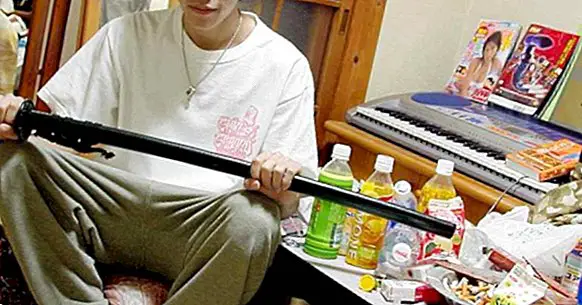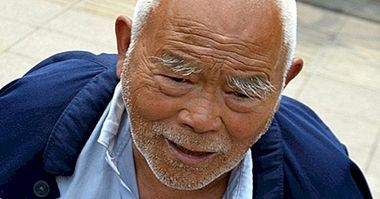Hikikomori: young people permanently locked in their room
If a person voluntarily retires to his home and does not have any type of work or academic or social activity for at least six months, he may be suffering from Hikikomori syndrome .
What is Hikikomori syndrome?
The term Hikikomori was coined by the psychiatrist Tamaki Saito , in the year 2000 and means to depart, be secluded . It is defined as a voluntary form of social isolation or self-imprisonment, due to both personal and social factors. It mainly affects young adolescents They are already sensitive, shy, introverted, with few friendly relationships and with a perception of the outside world as something violent that constantly assaults them. To all these precedents can be added the bad relationships within the family. There is a higher incidence in males.
His life develops in a room from which they do not come, Reflecting normally in a virtual world , surrounded by video consoles and internet, although recent studies have shown that only 10% of those who suffer from this pathology use the internet to interact with other people.
Social isolation
This process of isolation is gradual and begins when they begin to be confined to their room for more and more time, as if absorbed by the Internet, they stop calling and stay with their few friends and begin to neglect their studies. This is where this kind of social suicide .
Everything they do without leaving home, altering even their daily rhythms: they sleep during the day They eat in the afternoon and spend the night playing video games or watching television. They also neglect their hygiene and do not even communicate with their families. Some, they frighten their parents and have aggressive behaviors; others are overwhelmed by the sadness, obsession, anxiety and depression triggered by the confinement, reaching suicide in some cases.
Although this phenomenon comes from Japan and is associated with the demanding, competitive and individualistic culture of Japan, little by little it has spread like a pandemic to the rest of the world, although with different characteristics according to each society. In Spain, this syndrome also known as '' of the closed door '' has accumulated more than 200 cases in recent years . In Japan, those affected are counted in the millions.
The reason for not leaving home should be to the desire to be alone and a feeling of apathy towards the outside world coupled with the fear of leaving their protective environment, their small security bubble.
Types of Hikikomori
While all of Hikikomori's cases have isolation in common, not all of them carry it out in the same way or to the same degree. For example, the junhikikomori or pre-hikikomori He leaves from time to time or attends school or university, but avoiding any kind of social relationship.
The Social Hikikomori , who rejects work and studies, maintains some social relations, even through the internet. On the other hand, the Tachisukumi-gata presents a very marked social phobia and feels paralyzed by fear.
Finally, it would be the case ofl Netogehaijin , literally translated as "zombie of the computer" that are totally confined people that dedicate all the hours of the day that stay awake using the computer or other virtual means that they have at their reach.
Causes of Hikikomori
It seems impossible for a young person to be able to confine himself for months or even years between four walls without wanting to have any kind of relationship with the world, right?
The causes that are believed to trigger this disorder are currently mere hypotheses. Some think it's the technology and the virtual world in which young people live surrounded, losing contact with reality.
Others, however, point towards family factors (excessive pressure from parents for their child to succeed in life and little communication in the family by them) and socioeconomic s: social in terms of the pressure of society towards conformity and uniformity and rejection of what is different (this happens in a very marked way in Japanese society), and economic in relation to the working hours of the parents, who it prevents spending time with their children and makes it impossible to have adequate family communication.
However, looking for a single cause for a social phenomenon such as this would be an error, since it is most likely multidetermined.
Symptoms of Hikikomori
The main symptoms that could announce the isolation are:
- Refusal to attend school due to school bullying on many occasions
- Total loss of friends or love disappointment
- Scarce basic social skills
- Low self-esteem
- Depressive personality
- Excessive dependence on family relationships
- Insomnia or alteration of the daily rhythms (they sleep for the day and remain active at night)
- Family pressure to fulfill their role with society (study, find work) and to meet the expectations or plans that their parents have for them
- Little or no tolerance to frustration
- Etc.
Effects of Hikikomori on people
Voluntary seclusion for months or years can cause significant health effects, both physical and mental.
TO physical level the body suffers the effects of not doing any kind of physical exercise or eating a balanced diet like anemia, fragility in the joints, sores for lying too long without moving, etc.
TO psychological level , the absence of contact can make the young man lose almost completely his social skills to relate to their peers, while experiencing constant feelings of insecurity and guilt , which reinforces their behavior of staying locked.
Treatment for the Hikikomori
A standard treatment to address this problem has not yet been established, because it is a relatively new disorder and the confrontation between the Eastern and Western approaches.
In Japan, where this social upheaval originated, it is defended that the affected one leaves his isolation by his own means and of progressive form, without pressing it and trying to make him enter in reason. By contrast, in Western countries, experts recommend a firmer stance and attack the root problem, forcing young Hikikomori out of his room.
In the West more specifically, we can point out two major approaches in terms of therapies:
1. The medical-psychiatric method
This type of treatment treats the problem as a mental or behavioral disorder that demands recovery in the hospital and the use of drugs. Its focus is on reorganizing the family relationship with the patient, fostering communication strategies, so that parents are also involved in therapy. When the young man is sufficiently recovered to go to the clinic by his own means, he begins to work with psychotherapy sessions.
2. The psychosocial method
This method stakes the need for psychological support to help the victim Hikikomori out of his confinement. Usually, the young adolescent is moved away from home, staying later in a community with other boys and girls who suffer from the same problem, to foster coexistence, human contact, re-learn social and communication skills, etc. All this through activities that are attractive to them and that they can share as a group. It seems that the self-help groups have become a key element to achieve the social reintegration of those affected.
Differential diagnosis of Hikikomori
Due to its wide symptomatology, little defined at present, this disorder can often be confused with others of the type Agoraphobia, Obsessive Compulsive Disorder, syndrome of Diogenes , etc. To give an example, Hikikomori differs from agoraphobia in that, within their protected environment, they can lead a normalized life. Receive visits, call by phone, etc. An agoraphobic person isolates himself out of fear, although he wants to be able to be part of society and go abroad, while the Hikikomori rejects that option and voluntarily retires.
An investigation carried out by (2002) suggests that compulsive behaviors typical of OCD or other behaviors typical of the aforementioned disorders are only side effects of Hikikomori. Therefore, it suggests that the differential diagnosis of Hikikomori against depression, OCD, schizophrenia or other obsessive disorders together with early detection are essential for the early recovery of the person, since those affected by Hikikomori do not suffer from a disorder per se. In most cases, their behavior can be explained in a logical manner by the life they lead, the impact that society has on them, the culture in which they are immersed and their family and personal environment. They are normal people in a highly conflictive situation
The syndrome arrives in Spain
In a 2016 article, the psychologist Jonathan García-Allen echoed the increase in cases registered in Spain. So, it seems that this disorder may be starting to be a global phenomenon.
"Hikikomori cases increase in Spain"Documentary about Hikikomori
This documentary can help you better understand the Hikikomori phenomenon.



















